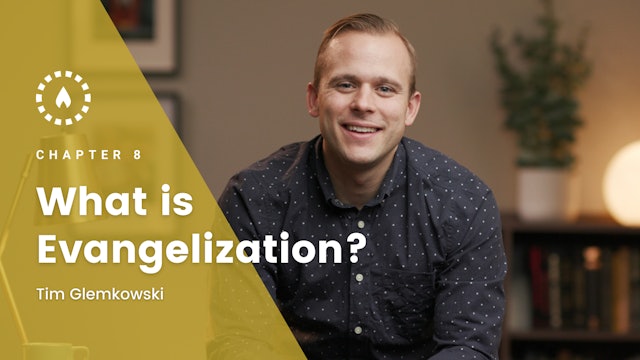-
Chapter 26: Conclusion
Tim gives a final fervorino to all parish leaders, encouraging them that this is a particularly special time in history to be focusing on the parish. The laity are the key to renewing our Faith in our culture and in our world.
-
Chapter 3: Why the Parish?
Is the parish worth saving? In this chapter, Tim shows us why the parish is vital and provides a few frameworks to view it with a more hopeful lens.
-
Chapter 2: Culture Change
Why do we need to talk about parish renewal right now? And what is the goal of parish renewal in the first place? Tim notes that it all starts with your parish culture and breaks down the reasons it is absolutely necessary to put our focus on our parish culture to succeed in renewal.
-
Chapter 14: Introduction
This chapter introduces the section on building a clear path to discipleship. Tim reminds us that this is our core identity as a Church, so we strategize on how to accomplish it.
-
Chapter 4: The Four Types of Parishes
This chapter is a self-diagnosis for parishes. Tim provides a framework of the four types of parishes. The diagnosis will serve as the starting point on your parish’s journey of renewal.
-
Chapter 7: What is a Disciple?
Tim makes a stark point: If we are going to talk about discipleship in our parishes and with our parishioners, the language must be crystal clear. This chapter discusses how you and your parish can better understand and communicate what discipleship truly is.
-
Chapter 8: What is Evangelization?
What is evangelization? It is the core identity of the Church! Tim gives us the process of evangelization and touches on the “New Evangelization” and why it is vital for parish renewal.
-
Chapter 12: Interiorizing a Vision
As a parish staff, you need to have a vision interiorized before you begin to cast it, and this vision needs to come from God. Tim discusses the necessity of prayer in forming your parish’s vision.
-
Chapter 10: Introduction to the Four Keys
This chapter provides an introduction to the four keys to culture change in a parish. These four keys will be covered in multiple sections with greater detail throughout the course.
-
Chapter 5: Introduction
This chapter introduces the section “What is the real issue?”. In the next few chapters, Tim will look at the cultural roots of inertia in our parishes and give us a run-down on the basic requirements that will make it possible for renewal to take place.
-
Chapter 6: The Real Crisis
Tim notes that the real crisis lies in nothing more than a lack of discipleship. Everything flows from that point. However, fixing that issue is easier said than done because the roots run deep. Cultural Catholicism is dying, and that poses challenges.
-
Chapter 9: A Snapshot of a Parish Today
A parish leader must understand their mission field. Tim gives us a data snapshot of those people who are in your parish today. This is key to being able to move forward with effective measures.
-
Chapter 1: Welcome
This course is for every parish leader – from the pastor to each volunteer – to give a firm foundation for effective, evangelical, and sustainable parish ministry. From chapters on the real importance of the parish to accurately identifying root problems in our parish culture, this course can imm...
-
Chapter 13: Communicating a Vision
Once you have the parish’s vision established, it must be communicated. Others have to see the point and the goal alongside you. Otherwise, it will never fully come to pass.
-
Chapter 16: Pre-Evangelization (Win Part I)
You must till the soil before you plant the seed. And how is this done? Tim says that pre-evangelization is entirely relational. We cannot evangelize without relationship formation taking place in our ministries and in our parish. Tim also gives the “Four A’s” which provide a framework for this p...
-
Chapter 15: Simple and Clear
Tim hones in on the most important starting point for people: make your parish ministries simple and clear. This might mean cutting down on some ministries so you can be more intentional with the ones you have. Tim also provides 2 different formulas for discipleship in a parish.
-
Chapter 17: Evangelization (Win Part II)
Evangelization is a very specific thing in the Church’s documents. Tim provides 3 methods by which this can be accomplished within your parish, following relationship-building.
-
Chapter 18: Discipleship
We need to accompany people to full growth in the Christian life. Tim provides further evidence of why discipleship is absolutely necessary following pre-evangelization and evangelization. He gives us the key to unlocking discipleship, which is community.
-
Chapter 19: Apostolate
Every baptized Christian is supposed to multiply and make more disciples. How does our parish prepare people for this mission and then send them out to accomplish it? Tim discusses all of these critical points in this chapter.
-
Chapter 20: Introduction
Tim introduces the next section on mobilizing leaders with a warning. If you don’t multiply your leadership, you will burn out. He gives two extremes in parish life that must be avoided if you want to mobilize your leaders.
-
Chapter 21: The 3, 12, and 72
Tim discusses the leadership structure that Jesus himself implemented, and then challenges us to imitate Him as we set up our leadership structure in our parishes.
-
Chapter 22: Start a Movement
Tim notes in this chapter that the end goal should be lay people operating creatively on their own. This vision can sometimes be a scary thought to parish leaders, but Tim further discusses why it is vital for your parish to become vibrant.
-
Chapter 11: Start with Why
If we are going to cast a vision for our parish, we have to start with the “why”. Tim notes that the initial battle your parish will have to fight will be to communicate and drive home answers to questions like “What is the purpose of the Church?”, “Why does our parish exist?”, and “Why am I Cath...
-
Chapter 23: Introduction
In this chapter, Tim introduces the section “Align Everything”. If our new vision as a parish is to make disciples, we should re-analyze everything we do as a parish in light of that core mission. We call this mission alignment; drifting away from that mission causes dysfunction.


























